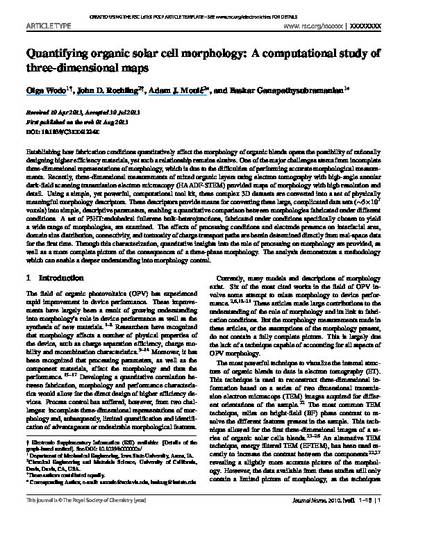
Establishing how fabrication conditions quantitatively affect the morphology of organic blends opens the possibility of rationally designing higher efficiency materials; yet such a relationship remains elusive. One of the major challenges stems from incomplete three-dimensional representations of morphology, which is due to the difficulties of performing accurate morphological measurements. Recently, three-dimensional measurements of mixed organic layers using electron tomography with high-angle annular dark-field scanning transmission electron microscopy (HAADF-STEM) provided maps of morphology with high resolution and detail. Using a simple, yet powerful, computational tool kit, these complex 3D datasets are converted into a set of physically meaningful morphology descriptors. These descriptors provide means for converting these large, complicated datasets (∼5 × 107 voxels) into simple, descriptive parameters, enabling a quantitative comparison among morphologies fabricated under different conditions. A set of P3HT:endohedral fullerene bulk-heterojunctions, fabricated under conditions specifically chosen to yield a wide range of morphologies, are examined. The effects of processing conditions and electrode presence on interfacial area, domain size distribution, connectivity, and tortuosity of charge transport paths are herein determined directly from real-space data for the first time. Through this characterization, quantitative insights into the role of processing in morphology are provided, as well as a more complete picture of the consequences of a three-phase morphology. The analysis demonstrates a methodology which can enable a deeper understanding into morphology control.
Available at: http://works.bepress.com/baskar-ganapathysubramanian/40/

This is a manuscript of an article published as Wodo, Olga, John D. Roehling, Adam J. Moulé, and Baskar Ganapathysubramanian. "Quantifying organic solar cell morphology: a computational study of three-dimensional maps." Energy & Environmental Science 6, no. 10 (2013): 3060-3070. DOI:10.1039/C3EE41224E. Posted with permission.